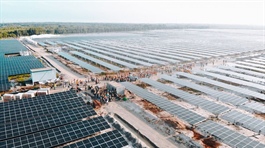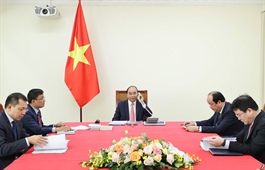Legal considerations for solar pilot
Legal considerations for solar pilot

Baker McKenzie Vietnam managing partner Frederick Burke and legal professional Mai Trang Le
|
While small-scale rooftop solar systems continue to expect additional incentives for on-site installations or self-consumption, for utility and mid/large-scale ground-mounted and floating solar farms connected to grids, the government has indicated its policy to gradually transition to a competitive auction mechanism.
Solar energy has already proven popular in Vietnam. As of August, 92 solar power projects in the country have reached commercial operation date (COD) with total capacity of 6,165 megawatt-peak (4,930MW). Nevertheless, statistics show that there is an obvious power shortage for the 2021-2024 period, estimated at 13.3 billion kWh in 2023 and 11 billion kWh in 2024.
The nationwide solar auction is intended to commence in June 2021, although the relevant studies and draft legal documents for this regime are still in progress. In fact, no draft legal documents for a nationwide solar auction have been published yet. Meanwhile, projects eligible for feed-in tariff 2 (FiT2) must reach COD no later than December 31. As the result, at the moment, it remains uncertain which pricing mechanism will apply to grid-connected solar power projects reaching COD in 2021.
To deal with this uncertainty, the Ministry of Industry and Trade (MoIT) recently proposed a special regime for solar power projects that miss the FiT2 COD deadline but need a power purchase agreement (PPA) and/or tariff rate determined during the waiting period for the government’s launch of the nationwide solar auction programme (transition phase).
In September, the MoIT dispatched Notice No.7200/BCT-DL to line ministries and Electricity of Vietnam (EVN), enclosed with the draft texts of the prime minister’s decision on competitive price selection mechanism for transition phase solar power projects (pilot programme). To prepare for this, on November 20 the prime minister issued Official Letter No.1632/TTg-CN to the MoIT approving inclusion of a list of solar farms, with total capacity of around 2,000MWp, into the amended National Power Master Plan VII (PDP7).

By the end of 2019, Vietnam surpassed Malaysia and Thailand to reach the largest installed capacity of solar panels in Southeast Asia, Illustration Photo: Shutterstock
|
Key features
The MoIT expects the pilot programme to commence by the end of this year and last until the end of May 2021 (meaning upon the launch of a nationwide auction programme). Ground-mounted solar projects and floating solar projects may participate, but public-private partnership projects and corporate direct PPA projects are expressly excluded.
As pre-requisites for participation in the pilot programme, among others, the solar project must have obtained approval of the competent state authority for inclusion into the relevant power development master plan and must have a proposed COD of no later than the tentative deadline of June 30, 2022.
The draft decision on the programme proposed certain participation restrictions, causing uncertainty to investors as to their chance of participation. Among other things, the total capacity to be selected from the programme is capped at 1,000MW (which accounts for only a small portion of around 11,610MW having already completed pre-feasibility study dossiers for PDP inclusion approval.
The total amount of capacity to be selected is capped at 60 per cent of all participating projects; and total capacity of project(s) of one investor must not exceed 20 per cent of the total amount of capacity to be selected through the pilot programme. This will be a disappointment to some developers.
In general, the key difference between the FiT regime and this pilot is that, instead of granting projects a fixed tariff, participating projects that have met the minimum permit requirements will propose their own tariff.
Projects with the lowest proposed power tariff will be selected to sign a PPA with EVN until the total capacity demand is met. The maximum proposed tariff rate for this pilot programme is the FiT2 under Decision No.13/2020/QD-TTg issued in April on encouraging mechanisms for solar power development in Vietnam, which is 7.69 US cents per kWh for ground-mounted projects and 7.69 US cents per kWh for floating solar projects.
In terms of selection procedures, participating projects in the pilot programme must go through several preliminary review and appraisal processes to be eligible to submit bid proposals (subject to the final text of the decision). The selection process generally comprises the following steps:
+ The MoIT reviews solar projects that have been included in the PDP, to prepare a list to participate in the pilot (tentative participants’ list);
+ The ministry circulates that list to provincial-level people’s committees, and will also circulate it to EVN for appraisal of the projects’ power evacuation capacity. The MoIT may update the list based on inputs from the provincial people’s committees and EVN;
+ The MoIT publicises the finalised tentative participants’ list, selection plan, and template of proposal dossiers on its website and the National Public Procurement System;
+ Investors submit proposals within 45 days from publication date of the MoIT’s selection plan on its website;
+ The MoIT finalises the list of projects participating in the pilot programme; reviews and selects projects based on the proposed power tariff; and issues the final list of selected projects;
+ These selected projects are issued the investment policy decision (or have their existing investment policy decisions amended) in accordance with the selection results; and
+ The projects continue to obtain project permits and approvals (including signing of the PPA) in accordance with existing laws.
The applicable tariff for the projects selected is the tariff proposed under the relevant template of proposal dossiers, and will be reflected in the PPA. Under Notice 7200, the MoIT proposes that the model PPA for FiT2 projects will continue to apply to projects selected through the pilot programme.
Nationwide auction
With a tentative launch within 2021 to be confirmed, the nationwide solar auction programme is expected to establish an effective, competitive, and transparent mechanism to select and determine tariffs for solar power projects. More consideration will be given to the technical and financial proposals of the projects, instead of considering only tariffs as proposed under the pilot.
The applicable template PPA should be expected to be improved in order to address certain key legal and contractual risk allocation issues of the current PPA template, such as curtailment issues, termination payment, and force majeure events. These proposed improvements are not yet concluded, subject to the legal documents to be issued and also the progress and implementation results of the pilot programme.
Investors may take into account the possibility of participation in the programme for solar projects included in the amended PDP7 but which are not eligible for FiT2. For solar power projects with later development schedules (for examples, those currently applying for inclusion into PDP8 or those with anticipated COD after June 6, 2022), potential investors should keep track of the development of the legal framework for the nationwide solar auction programme, which tentatively will be released next year.


























